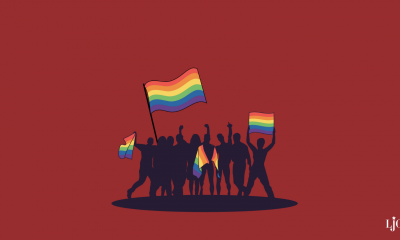Arts & Entertainment
A non-binary Cuban artist is born again in Spain
Nonardo Perea suffered persecution in his homeland
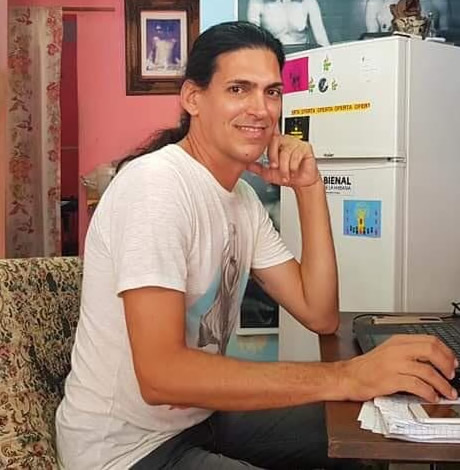
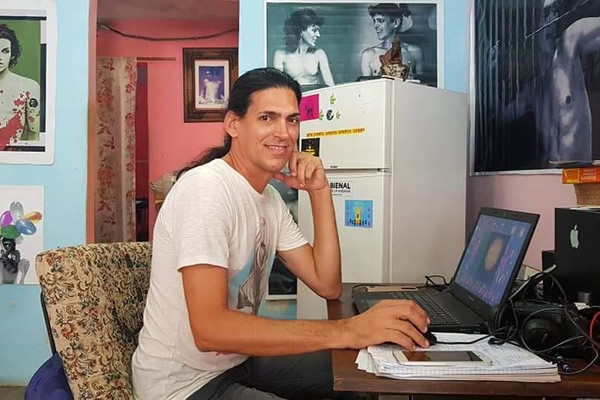
MADRID, Spain — Nonardo Perea lives in Michel’s body. He uses it at will to be vulgar, angelic or diabolical, male or female. Nonardo can be whatever he wants. Michel, shy and withdrawn, hides behinds that alter ego that lends him his face and hands to show the world his claims as an artist.
Nonardo is an invention that comes to life in photographs, video art, performances, stories, installations, journalistic articles, ceramics, and whatever other format is possible, since Nonardo long ago lost any limits. His mind lost that ability as he reinvented himself as an empirical artist, as no one ever gave him the opportunity to attend art school.
He has been greatly misunderstood, mainly because his pieces overflowed with eroticism and Cuba is still too prudish to appreciate his queer art and his other works the regime has labeled as “politically incorrect.” Michel and Nonardo were discriminated against by society and the dictatorship that governs the country and represses anyone who does not agree with its dogmas.
Nonardo nevertheless overcame those barriers and began creating, without anyone’s guidance. He was first a writer and received some tools once he graduated from the Onelio Jorge Cardoso Literary Training Center in Havana. He won several competitions, such as the 2017 Franz Kafka Prize for his work “Los amores ejemplares” and the 2012 Félix Pita Rodríguez Prize for the novel “Donde el diablo puso la mano.”
In the visual arts, where he is usually very restless, he won the third prize for photography at the GendErotica Festival for “La casa por la ventana 2014” with his Vulgarmente Clásica project. He participated in the Bienal 00, organized by independent artists, with his “En la cama con Nonardo” project and presented Vulgarmente Clásica at Madrid’s La Neomudéjar Museum in 2019.
Nonardo belongs to the San Isidro Movement, a group of independent artists and intellectuals who fight for a democratic Cuba. That battle has also been fought through his art and in pursuit of LGBTQ rights, such as marriage and adoption rights for same-sex couples, and an end to gender violence that remains a problem on the island.
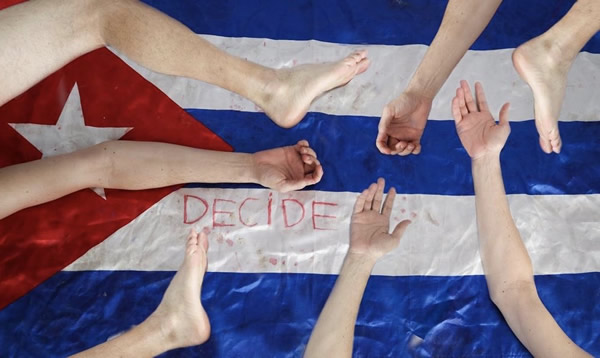
Due to his work and political activism for a truly democratic Cuba, Nonardo suffered police harassment and Cuban state security agents threatened him with jail. Fearing for his life, he took refuge in Spain, a country where he feels he has been reform and from which he speaks with the Los Angeles Blade.
LOS ANGELES BLADE: Those who follow your art on social networks and off of them know you as Nonardo, but few know that your real name is Michel. How and why was Nonardo Perea born?
NONARDO PEREA: I remember starting my writing career and I needed another name that was not so common. I did a big search and I didn’t like any of them. I wanted a unique name if possible. One afternoon I was sitting in the living room of my house with my father and I told him about the need for a name. It was he who proposed Nonardo. At first it sounded a bit ugly to me, but then with Perea it seemed a little better. It had strength. I liked it because it began with “no”, denial, and was followed by “nardo”, flower, that is, Nonardo had a lot to do with me. Since then I started using it for all of my work, both literary and audiovisual.
BLADE: How does your artistic training take into account that you are an empirical creator?
PEREA: My artistic creation from the beginning was always very complicated, taking into account that I had to abandon my studies at an early age for inclusion reasons, so I have no academic training; then add to that that I am a very obvious gay. At one point in my teens I was seen as a person who was too feminine. The fact of looking like a woman was a problem when trying to fit in a macho and homophobic society. Where I first tried to break through was in writing. I started by attending literary workshops, where I won several contests quite quickly. I was never exempt from criticism and rejection of the themes that my narrations addressed, which almost always focused on LGBTQ issues and dirty realism. Many times I felt that being the way I am made many uncomfortable. But despite the rejections and bad times that I lived in various periods of my life, I continued doing narrative, and I also began to write articles about social issues for the Havana Times digital newspaper. Then, over time, I had the opportunity to apply to a video journalism workshop in Prague organized by the People in Need organization, and thanks to a woman I love very much, Clara González, who saw some potential in me, I was accepted to participate in the course, in which I learned some video editing, and received help with equipment that helped me to start doing audiovisual work with better quality. All my creative works have been done empirically, and above all I am an artist who works based on improvisation.
BLADE: You have ventured into artistic genres as different as writing, journalism and acting. How do you define yourself as an artist and why?
PEREA: I am a person who cannot be inactive. I spend every day of my life thinking about doing something new. Sometimes I have so many things on my mind, and the fact that I can’t do everything I want to do makes me feel a bit frustrated. I have no words to define myself, I can only say that in some way my creative processes have helped me to cope with the life that I had to live, everything I have done and do has served as a way of escape from reality and everyday life, I could no longer live without creating.
BLADE: In a recent interview you precisely declared that your art was a process of liberating yourself. What exactly do you free yourself from when you create?
PEREA: I free myself from the day-to-day, the everyday, my fears and censorship.
BLADE: In most of your visual works you work with your own image. Why?
PEREA: I use myself as an artistic object because in Cuba I lived in solitude for a long time. I somehow isolated myself and created a space of comfort in my home, a place where I felt more free. The confinement somehow helped me to stay away from society that did not tire of making me feel bad about my obvious homosexual condition in much of my youth. My literary proposals and art in general, on the other hand, were not taken into account. I always perceived that most people underestimated me, and proposing someone to collaborate with me on erotic photographs without receiving anything in return was complicated, and still is. I have control over my body. If I want to undress in a photo or in a video, even if I feel sorry, I strip myself of complexes and do it. If I want to take a photograph that is too vulgar, I also do it. I do not have to request permission from anyone to do so. I don’t put up barriers. I take a risk, then I think that they say what they want. I understand that I am doing a job where I express my personal and social problems, as a human being.
BLADE: You identify yourself as an androgynous person. How many difficulties has that brought you considering that you have lived most of your life and developed your work in Cuba, a country where macho and homophobic ideals still predominate?
PEREA: I consider myself a non-binary androgynous person, because I do not identify with any sex. I can feel at ease as a girl as well as a boy. I have no problem with male or female pronouns. I do not like to victimize myself, but I can tell you that the road has been very difficult, and it has been not only for me, but for many other gays and lesbians who have chosen not to hide their sexual identity in their lives and have had to fight against the world. Being who I am in Cuba has not helped me much in terms of being able to be recognized for my work, but being who I am has helped me to strengthen myself and to understand that I do not need the approval of any institution to continue creating. I am a Cuban artist and like it or not, a large part of my work was created in Cuba.
BLADE: Many Cuban artists prefer to separate their creations from politics and even refuse to give their true judgment on the situation on the island. However, your work has a high dose of activism against the dictatorship and in defense of LGBTQ rights. What consequences, professional and personal, has being an artist labeled by the Cuban regime as “counterrevolutionary” brought you?
PEREA: The main consequence is that I had to go into exile; leave the country where I was born, abandon my mother and family, my friends, my dogs and a lifetime. But I think it had to be that way. There was no other way than to say goodbye, because under no circumstances was I going to allow my creative processes to stop, and above all I was going to continue doing my activism. I know that perhaps I was not going to be able to withstand so much pressure from state security agents, who wanted me to collaborate with them to expose my colleagues from the San Isidro Movement. If I returned to Cuba right now, I don’t know what my life would have been like from that moment on. If being a counterrevolutionary means saying what I think, and being in favor of oppressed minorities, and being against a dictatorship that has left Cuba and its people in a nameless misery for 61 years, then I am a counterrevolutionary and with great honor. I have nothing for which to thank that country, where I was always seen as a freak, and what little I got was thanks to my effort and dedication, because while in Cuba I received criticism and obstacles for everything, for this reason they are collecting what they sowed with me, they do not expect roses from me.
BLADE: In Cuba, to be accepted as part of the official LGBTQ movement you have to share the ideology of the dictatorship, the same one that put equal marriage to a popular vote and represses independent activists. In your opinion, what are the dangers of “politicizing” the struggle of the Cuban gay movement?
PEREA: The danger is in seeing how it becomes politicized. While in Cuba, I never stopped going to the marches staged by CENESEX (the National Center for Sexual Education) and I will not forget how Mariela Castro (CENESEX’s director and the daughter of former Cuban President Raúl Castro) herself politicized those mini-carnival marches with slogans in favor of the five spies imprisoned in the Empire (a reference to the U.S.), and with cries of “socialism yes and homophobia no.” I do not remember seeing any gay or lesbian carrying a sign demanding equal marriage, or demanding freedoms, or a law against gender violence. It is really pathetic considering that the system itself is the number one cause of the persistence of homophobia and constant abuse of people from the community, mainly transgender people, in Cuba, a country where your rights are constantly violated, either because of race or sexual orientation. Those marches were politicized by CENESEX itself in favor of a supposed socialism, which has never worked and will never work because that is a hybrid between communism and underdeveloped capitalism, and we all know that it is nothing other than a dictatorship, and of the crudest in history because it has managed to last for 61 years. If Mariela Castro and all her loyal followers politicize the march for their benefit, I don’t see why the community cannot independently arm its own fight in favor of the most basic rights of the LGBTQ community in Cuba.
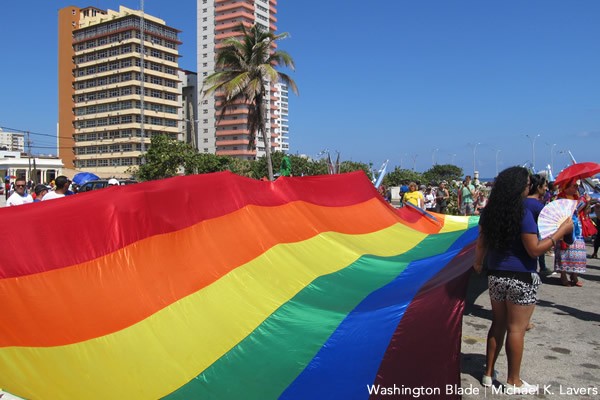
BLADE: In what way has the forced exile that you have faced in Spain changed your work?
PEREA: Right now I continue to do what I want to do, regardless of being in Spain. I still feel that I am in Cuba. My vision as an artist has not changed much. I’ve only been here a year and seven months, although I believe that wherever I am, in some way my work will be linked to that of the island because I have not yet cut that umbilical cord that links me to the place where I was born and took my first steps. It is true that one acquires other mechanisms of creation and invoicing in the work while abroad, but at the moment I do not think that the focus of my work has changed much because of being in another country. Of course, here in Europe there are other problems that I may be able to take advantage of, but be that as it may, they will be appreciated from the perspective of an exiled Latin American artist.
BLADE: On a personal level, what has it been like to be a gay immigrant in Europe?
PEREA: I am very grateful for Spain, mainly for Madrid, which is the place where I have lived since I arrived in 2019. At the moment, I have not felt discriminated against because of my sexual orientation or because I am a foreigner. I have received emotional and legal support from the NGO Rescate, which welcomed me and where I have received the care that I never had in my own country. With all the social and political problems that may exist, it is in this country where I have somehow been able to know what true freedom is.
BLADE: What can we expect from Nonardo Perea in the near future?
PEREA: I am in another difficult moment in my life right now, because I cannot find a job, and I do not receive any money for my artistic work, so what I do is for the love of art and because I cannot stop building my own world. The COVID situation has managed to make things more difficult, not only for me but for everyone, but taking into account that I am an exile and that I have been here for a short time, it is very complicated. Even so, I eventually continue to make video art for the Vulgarmente Clásica audiovisual project, which I have been doing for several years. And more recently I started with a new project, “Maricón Tropical: Living in Madrid”, this one is a bit more comprehensive not to call it ambitious because I insert various artistic manifestations: Performance, audiovisual, literature, drawing and photography, and it is focused on my new life as an exile in Madrid, everything seen from a self-referential point of view, as are almost all my proposals.
BLADE: If you had to create a work that describes your life right now, what would it be like?
PEREA: I consider that my life, my true life, has started now, what it was before was not. For the purposes I was born on March 19, 2019, when I set foot in Spain. All the past is left behind. I want to imagine that the past was a bad dream. My “Maricón Tropical: Living in Madrid” project is a work that somehow reflects that past, which is unfortunately impossible to forget and it is also good that people know what that other life was like, but I focus more on the present, my current problems as a person who faces a new life as an adult who feels like a newborn. I can only tell you that my life’s work is in progress.
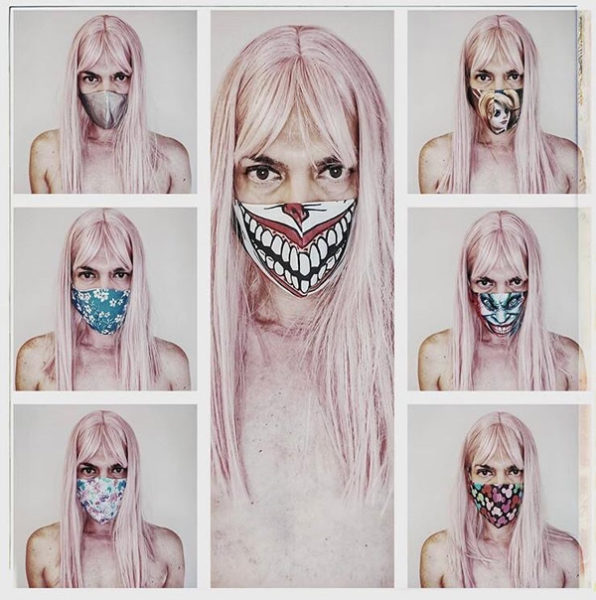
a&e features
Charles Galin King brings cultural influences and style to Revry’s ‘King of Drag,’ the first-ever drag king television competition series
When Charles Galin King made his big debut on the world’s first drag competition show, King of Drag, you knew you were taking in a star.
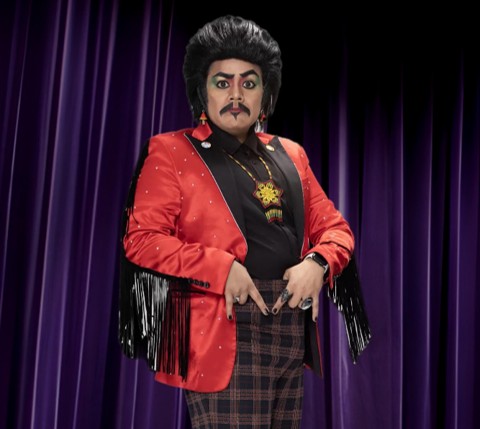
When Charles Galin King made his big debut on the world’s first drag competition show, King of Drag, you knew you were taking in a star. He introduced himself as “a Mexican-American Indigenous Wixárika with Ch’ol blood person,” and you couldn’t help but take notice.
His cultural influences are apparent in his drag, serving distinct and memorable looks. He won fans over with his fabulous impression of Nosferatu on The Dong Show and connected with them through his honesty about his mental health struggles. After bringing the black plague to the prom, his time on the Revry series came to an end.
We caught up with Charles Galin King to talk about his experience on King of Drag, what he hopes to see in future seasons, and advice for new drag kings.
Tell us about your first time in drag.
Back in high school senior year, I decided to wear one of my dad’s black button-up short-sleeved shirts and made a beard and mustache on my face, and wore a fedora hat. I went out with one of my best friends to this day, Ruben, and we went to Hollywood and went to Jack and the Box. I needed the restroom and went to the women’s, and a guy coming out of the men’s said, “Not that one, this one.” And I felt validated in drag cause I was that convincing of a “man,” jajaaaja.
What made you decide to be a part of the inaugural season of King of Drag?
I wanted to try it cause I was looking at the application out of curiosity, and upon reading started feeling fear and nervousness. And said, “I should apply,” to my mother. Also, l will die one day, might as well go for it and see how it is. I knew I would be a part of the first trial and error cause it’s a first of its kind, so we all learned together what this show is and will be.
What do you hope to see differently in future seasons?
More kings on the King’s Court, and more BIPOC judges, and more lip sync songs.
What surprised you most about your experience on King of Drag?
I gained 9 new siblings and felt a beautiful connection to myself in wanting to be a part of this community even more because of them. And due to being a beautifully diverse experience.
What do you cherish most about your filming experience?
I showed what drag means to me and what my drag is. And being able to say thank you to the cast, crew, tech, and owners of the studio where filming was at.
If you could do one thing over on King of Drag, knowing what you know now, what would it be?
Have more money and be able to show my true fear of cutting out a fetus from me and showing myself dying.
Have you had any especially memorable fan interactions since the show began?
Yes, when people and fans would say thank you for sharing your story about accepting death and suicide. And them asking me what surprised me most about being on the show.
Do you hear from other kings about the representation the show offers?
Yes, very much. They feel seen and have been wanting this for such a long time, and it’s a breath of fresh air seeing us all work together.. We still feel the hate from those who don’t understand our existence, though I have learned from my kings on the show that with every hate comment, there are ten love comments from the fans.
What do you want aspiring kings to know about the working life of a king?
Be prepared to be looked at by certain audiences with stares of confusion, and being on their phone when performing or being compared to other kings. Also, since we are still climbing to be accepted in this world, the majority of Drag Race fans still see us as non-existent and trash. Always focus on our drag king audience, for they understand us the most. Always have fun, for if I have fun, then the audience will have fun alongside me. SO many queens support us, and there are still queens who look down on us. Accept that and focus on your music, routines, lyrics, and feeling the vibes of what character you will put on stage.
If you can ask a co-star or Murray Hill one question at a season 1 reunion, what would it be?
What’s your favorite flavor of ice cream if you eat ice cream? And when can we hang out and look out to the sunset and high-five when it’s time to go home?
Stream the entire season of King of Drag now on Revry.com and follow Charles Galin King on social.
Events
The Blade wins Excellence in LGBTQ+ Reporting Newsroom Award at NLGJA Los Angeles Press Pride event
The Los Angeles Blade, HuffPost’s Lil Kalish, and GALECA’s John Griffiths took home top awards at Press Pride Prom, a benefit and awards ceremony held at Grand Central Air Terminal on July 26, 2025.
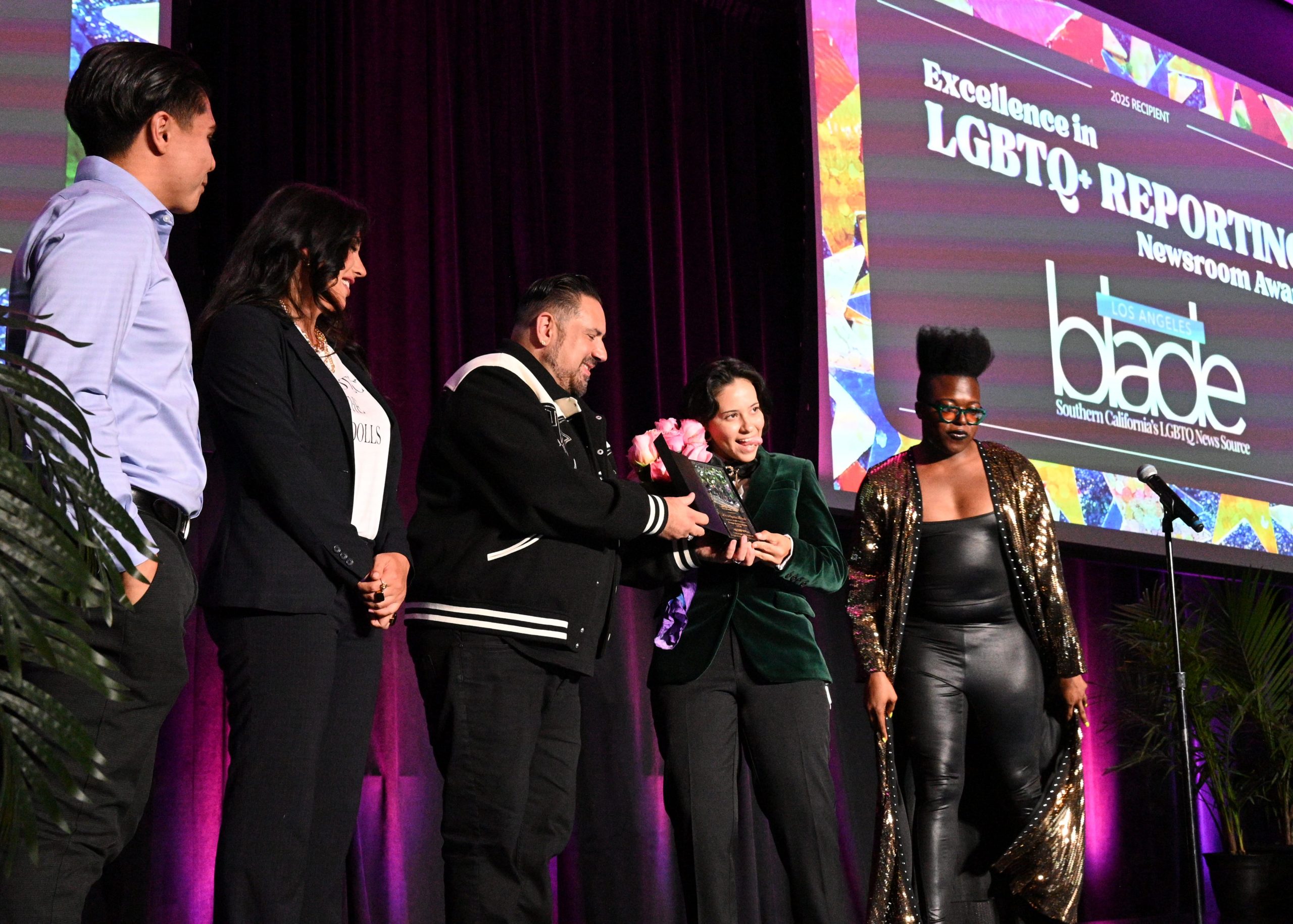
Members of the journalism industry gathered together this last weekend to celebrate the nominees and winners for three inaugural journalism awards for Southern California journalists and newsrooms who championed LGBTQ+ stories in 2024. The Los Angeles Chapter of NLGJA: The Association of LGBTQ+ Journalists presented this Press Pride Prom inaugural event.
Over 200 attendees gathered in Glendale at the historic Grand Central Air Terminal to celebrate. The evening was presented by ABC7 and hosted by award-winning journalist Tracy Gilchrist. The ceremony also included a moving performance by the Trans Chorus of Los Angeles and a hilarious appearance by drag king Charles Galin King.
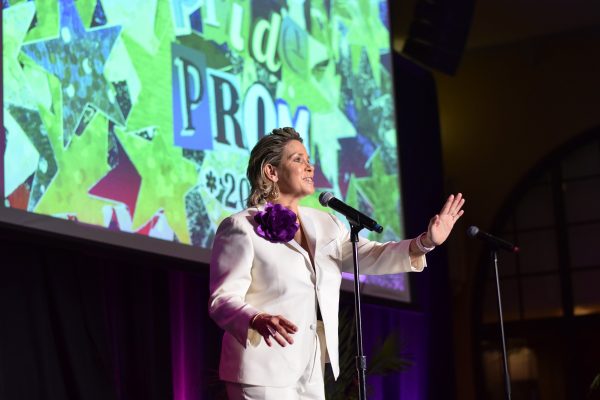
The Los Angeles Blade took home the first award of the evening, the Excellence in LGBTQ+ Reporting Newsroom Award. The award recognizes a news outlet whose coverage of the queer and trans community is well-informed, complex, varied, and intersectional, with a track record of promoting The Association of LGBTQ+ Journalists’ mission to advance fair and accurate coverage of LGBTQ+ communities and issues. The other nominees were LAist and Variety. Team members of the Blade took to the stage, including publisher Alexander Rodriguez, writers Rose Montoya, Rob Salerno, and Joel Medina, and former editor Gisselle Palomera to accept the award.
The evening also included the presentation of the Queer Beat Award for Excellence in LGBTQ+ Reporting, honoring a single story or series that demonstrates care, skill, and a commitment to fair and accurate reporting of LGBTQ+ themes, issues, and people. This year’s winner was “She Was Supposed to Be at Pulse Nightclub — And Club Q. Now She’s Fighting To Keep LGBTQ+ People Safe” by Lil Kalish for HuffPost.
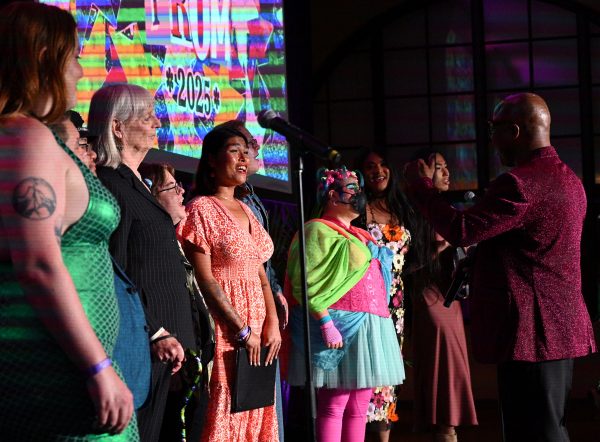
Another special moment for the Blade took place in the presentation of The Troy Masters Legacy Award for Visionaries in Media, presented in collaboration with the Blade and LA NLGJA, honoring a journalist or news media professional whose work reflects a dedication to the craft of journalism and a commitment to setting the stage for the next generation of LGBTQ+ industry leaders. The award is named in honor of Troy Masters, veteran queer journalist and former publisher of the Los Angeles Blade, who passed away last year.
This year’s winner was John Griffiths, founder of GALECA: The Society of LGBTQ
Entertainment Critics and Dorian Awards.
The final presentation was presented by the office of State Assemblymember Rick Chavez Zbur, for District 51. Joshua Marin-Mora gave a moving speech and delivered proclamations to each of the winners.
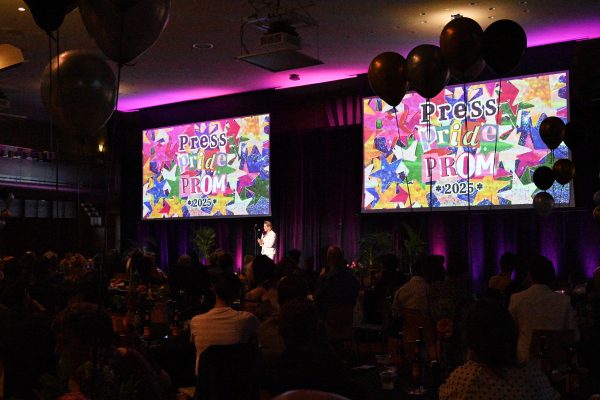
We are honored by our win and extend our congratulations to the LA NLGJA for a successful and important evening. A big thank you to our readers, who continue to support our efforts.
Movies
Restored film offers inside look at ‘80s gay Berlin
‘Taxi zum Klo’ feels authentic to anyone familiar with ‘hook-up’ culture
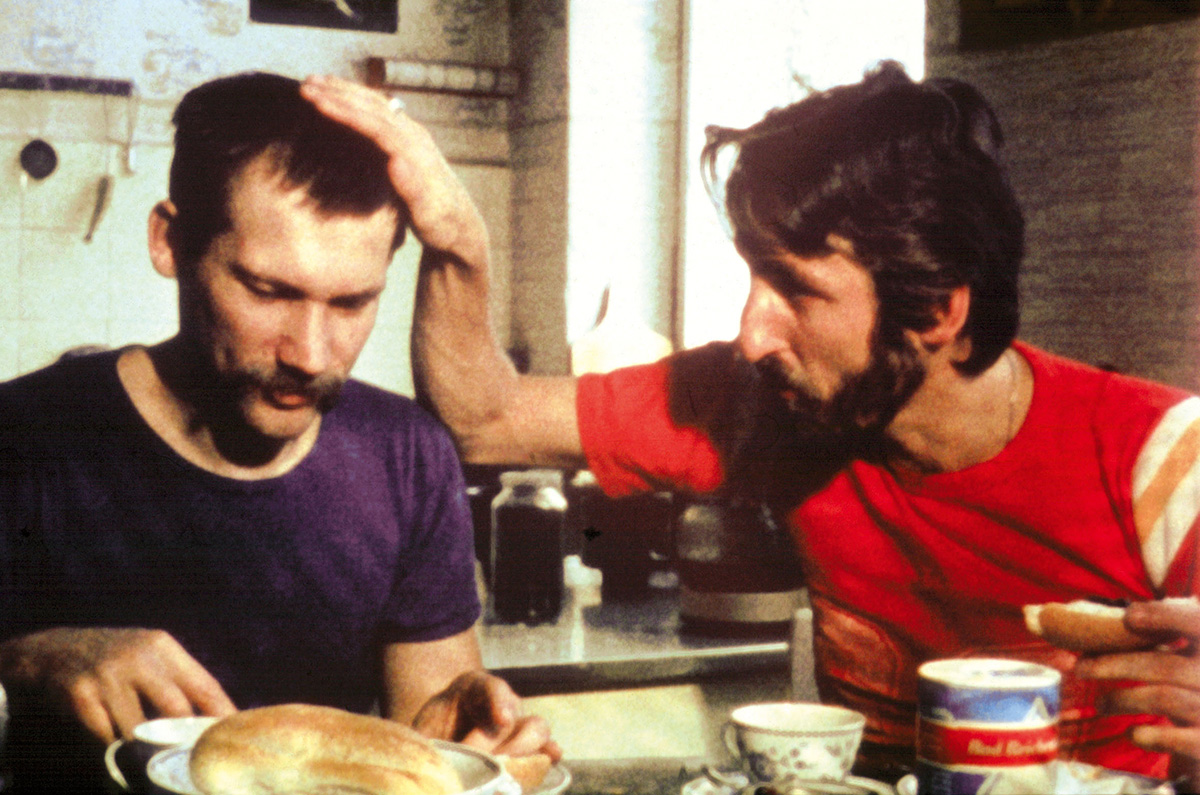
When “Taxi zum Klo” was released 45 years ago, it’s doubtful that anyone realized the extent to which the time and place in history it was capturing would someday be iconic — but watching it today, in a new 4K restoration which begins a multi-city “roadshow” tour in New York City this weekend, the world and the lifestyle it shows us feel not only familiar, but woven inextricably into the DNA of gay culture as we know it.
An underground sensation in West Germany upon its initial release, it made its U.S. premiere at the New York Film Festival in 1981, and was given a theatrical release in America that same year. It quickly achieved cult status, becoming a hit with queer audiences even as it became a flashpoint of controversy and a target of censorship in the repressive sociopolitical atmosphere of the Reagan era. Poised between the heady “golden years” between the rise of Gay Liberation and the nightmare of the AIDS epidemic, it offered a then-shockingly explicit, inherently transgressive inside look at the “secret” world of gay Berlin, in all its promiscuous, leather-clad, gender-bent, unapologetic glory.
Written, directed, and starring Frank Ripploh, it’s a semi-autobiographical and deeply transgressive exploration of gay German life through the experiences of a schoolteacher (Ripploh), popular with his students and well-liked (though gossiped about) by his colleagues, who leads a double life in the streets of Berlin on a quest for anonymous sex with other men. One such playmate (Bernd Broaderup) becomes his lover, and they move in together, enjoying the pleasures of domestic life even as Frank continues to pursue his hedonistic obsessions; Bernd, who longs for a simpler, quieter life in the country, grows increasingly dissatisfied, but Frank, despite his genuine affection for his partner and need for the centering emotional connection their relationship provides, cannot imagine a life without the thrill of his sexual adventures, bringing him to a crossroads where he must contemplate a choice between two lives — neither of which he feels can ever deliver the complete fulfillment he desires.
Produced on a shoestring budget, with Ripploh and his cast of non-professional actors playing characters who share their real names and a cinematic style that seems equal part candid documentary and absurd comedy of manners, “Taxi zum Klo” feels thrillingly authentic to anyone who has ever participated in gay “hook-up” culture — though the lifestyle it presents might also feel like a far cry from its modern equivalent, in which “dating” apps like Grindr and Sniffies have largely replaced the non-virtual sex clubs and porno theatres of a grungier and less impersonal time. There’s no exchange of “dick pics” here, no convenient listing of stats, likes, preferences or pronouns — just the unpredictable and potentially risky rituals of in-person connection. For those too young to remember when such things were the way of the gay world, the behavior of Frank and his various fellow “sex-plorers” might well seem just as scandalous as it would have been to the homophobic prudes of its day.
Likewise, there’s something about the film’s unabashed graphic nudity and sexual content that seems more “obscene” than the raunchiest OnlyFans content; Ripploh’s fearless choice to show male nudity, complete with erect penises and un-simulated sex, brings a visceral (and vaguely unsanitary) reaction that’s as inflammatory as it is erotic.
Still, Ripploh’s movie cannot help but arouse us; its raw and un-romanticized prurience makes it somehow easier for us to imagine ourselves as a participant despite (or perhaps because of) the voyeurism it evokes, and the effect is both lascivious and liberating, inviting us to embrace our sexuality as a visceral part of our queer identity — a concrete and gloriously queer touchstone of natural human experience that feels validated by the instinctual response it evokes in our physical being, defying any construct of “appropriate” behavior through its undeniable ability to turn us on.
Ripploh, who passed away from cancer in 2002, was in real life both an actual secondary school teacher and a popular drag performance artist known as Peggy von Schnottgenberg, made “Taxi zum Klo” while he was on probation from his job, a disciplinary action imposed by school authorities after coming out as gay on the cover of Stern Magazine in 1978. In a later interview, he said of the film: “I was not pursuing any political goals, but rather realizing purely private interests: my career as a teacher was ruined. And the film fulfilled a very simple desire for revenge, along the lines of ‘I’ll get back at you’.”
He also claimed it was not intended as a “gay movie” at all. Rather, he described it as “a sad film that expresses the longing for a relationship and its impossibility, despite all the humor… I definitely wanted to confront two dead ends: a bourgeois dead end where someone suffocates in pillows, coffee and cake, and a dead end of pseudo-free gay sexuality where you use drugs to blur boundaries but not eliminate them.”
Although his film was made decades ago, it’s those same conflicts, as much as any “shock value” or sex-positive embrace of our libido, that resonate with us now. While we may thrill at recognizing ourselves in its seminal portrait of liberated gay sexuality, it’s the still-potent longing to reconcile our conflicted impulses that speaks to us most urgently.
In a time when we face a struggle to keep ourselves from being shoved back into the shadows, it offers a powerful — yet still defiantly joyful — reminder that our real human struggle toward happiness on our own terms transcends all the irrelevant differences of sexual identity for which we have been continually persecuted, and inspires us to say, yet again, “we’re here, we’re queer, get used to it.”
Books
New book compiles interviews with 20 prominent gay authors
‘Passionate Outlier’ reveals interconnectedness among queer writers
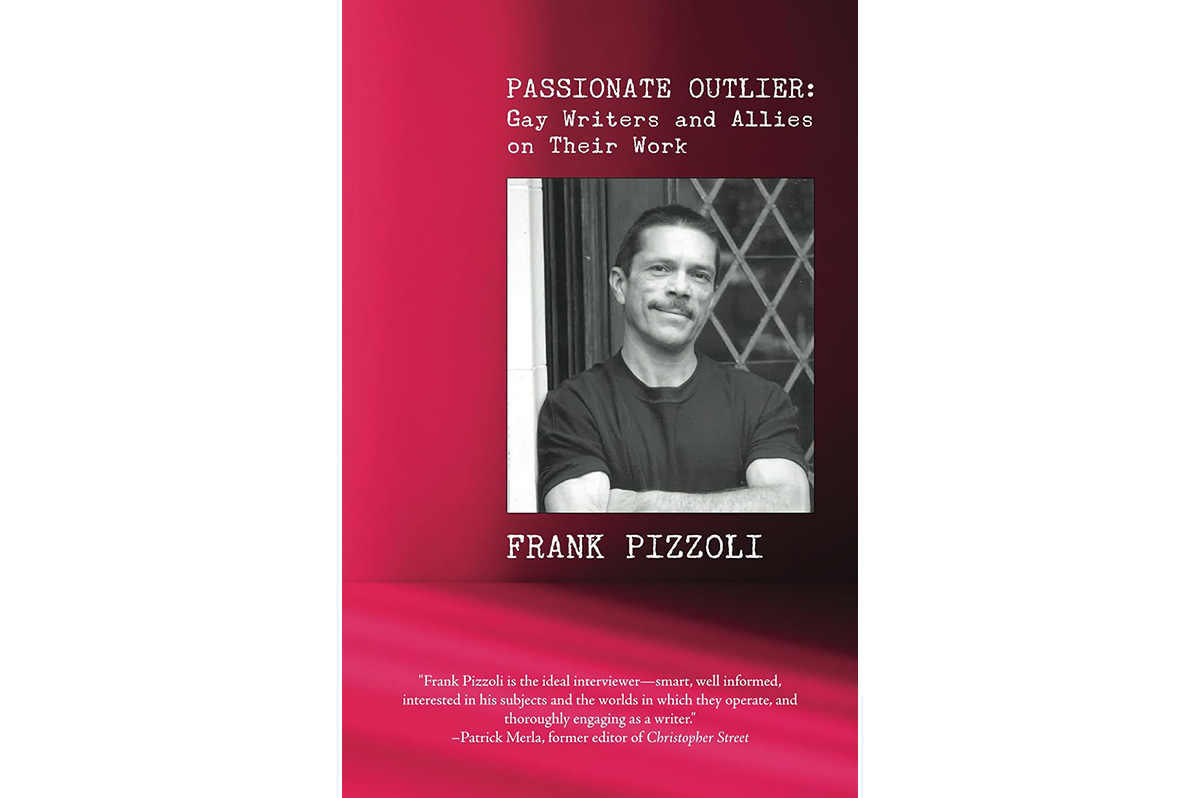
‘Passionate Outlier: Gay Writers and Allies on Their Work’
By Frank Pizzoli
c.2025, Rebel Satori Press
$18.95/246 pages
“Passionate Outlier” is a collection of 20 interviews and book reviews by freelance journalist Frank Pizzoli, covering gay authors, with one lesbian and one ally. Ranging from 2007 to 2019, Pizzoli talks with authors like Edmund White, John Rechy, Daniel Mendelsohn, and Salman Rushdie, and covers books about Gore Vidal and Christopher Isherwood. He captures great writers speaking about literature, politics, and gay life, while providing all necessary background on them.

Sadly, two of Pizzoli’s subjects, Edmund White and Felice Picano, have passed away since the book’s publication. Both writers were part of the “Violet Quill” a group of New York gay authors that met in the early ‘80s. Pizzoli interviews the then three surviving members, White, Picano, and Andrew Holleran. They speak at length about the history of the group and its myth. They only met eight times from 1980 to 1981, divvying up subject matter among them, and as they mention, writing is mainly a solitary activity. Yet the idea of the group endures as helping shape gay literature as a serious genre, not just “pornography” as it was previously considered. They also discuss White’s passionate argument with a critic over the very idea of gay literature; White believed in it, while the critic fiercely thought it was impossible. White also mentions that the harshest reviews of his work came from other gay men. Indeed, he responds to criticism from other authors included in this book, such as Daniel Mendelsohn and Christopher Bram. This back and forth throughout makes the book feel like an extended conversation between several writers.
Gore Vidal also serves as a connecting thread. Although he died before Pizzoli could interview him, his presence is greatly felt in many pieces. A review of Michael Mewshaw’s memoir of his friendship with Vidal, and an interview with Vidal’s official biographer Jay Parini show Vidal’s “thin skin,” drunken conversations, and litigiousness; he threatened to sue White over a play that imagined conversations between a Vidal-like figure and Oklahoma City bomber Timothy McVeigh. Christopher Bram, author of “Eminent Outlaws,” a history of gay writers, discusses Vidal’s intense rivalry with Truman Capote. Vidal’s works were deeply researched, but Capote was the more natural writer. Others talk about how his longtime partner Howard Austen was the only one who could get him to “shut up” when he was misbehaving.
Pizzoli allows the authors to reveal themselves in conversation. John Rechy, famous for his debut novel about male hustlers, “City of Night,” was Mexican-American but light-skinned enough to pass; a teacher changed his name from Jose to John. “City of Night” came from letters he wrote friends, which he sent to a magazine as the beginning of a novel, which forced him to write. He felt like writing the novel was betraying the secrets of the hustlers, prostitutes, and customers he knew so well.
Scholar, playwright, and novelist Martin Duberman discusses the political history of the gay rights movement and its connections with similar struggles, arguing that the Black Movement’s embrace of their difference helped gay people accept that they were not “inferior” to straight people. He wonders if marriage equality will lead to gays accepting government wrongdoing, because protesting would show “ingratitude.”
A surprising interview is Salman Rushdie, whose novel “The Golden House” has a character struggling with gender identity. He carefully researched the subject and spoke with friends to get it right. With thoughtful questions and reflective responses, “Passionate Outlier” shows the talent, diversity, and interconnectedness among gay authors.
The Blade may receive commissions from qualifying purchases made via this post.
Movies
The personal becomes political in explosive ‘Eddington’
COVID-era film will challenge your thinking, disrupt your comfort
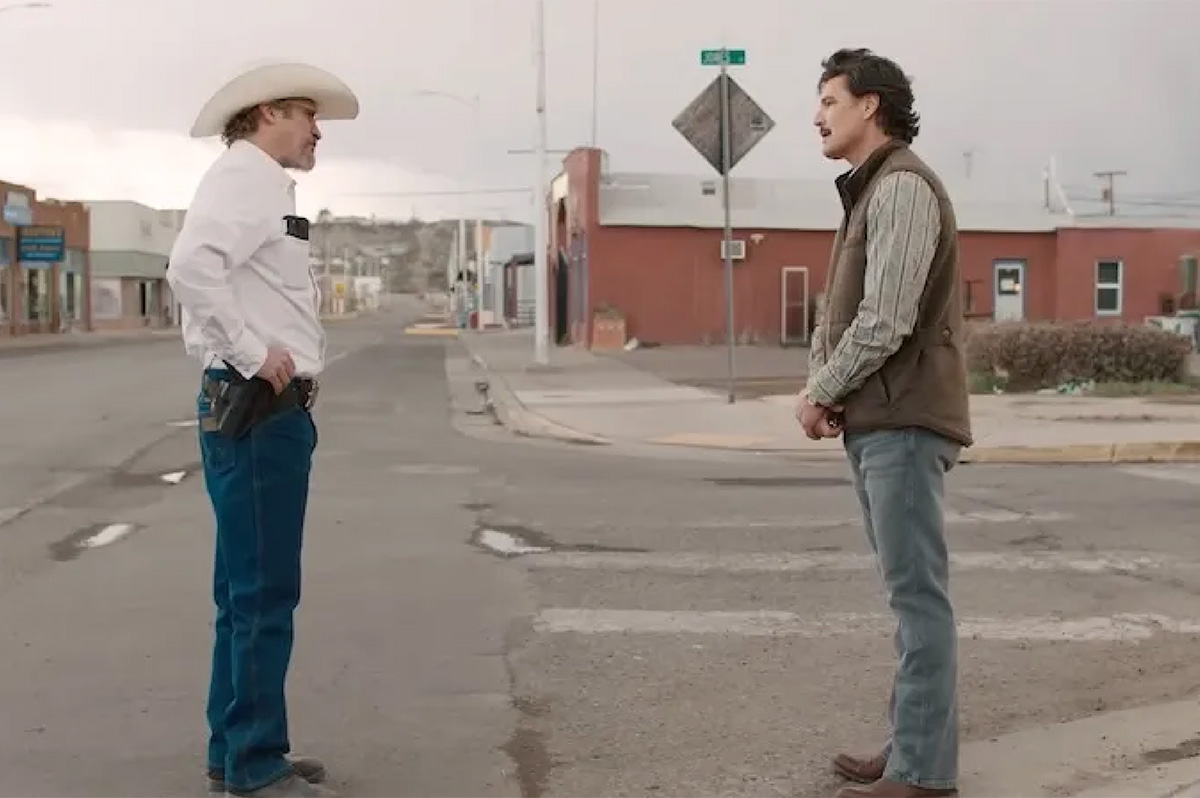
As the recent conservative blowback over “Superman” has clearly illustrated, many American moviegoers like to complain that movies have become too political.
The arguments vary; some claim that an overemphasis on social issues has made going to the movies feel like attending a lecture, or that cultural agendas have infiltrated a popular art form that is “supposed” to provide escapist entertainment. Others see it as a deliberate effort to “brainwash” audiences into acceptance of certain political ideals, depending on which side of the fence they may be on.
If you can relate, we understand your feelings, and we sympathize – but, and we hate to break this to you, every movie is inherently political.
For a film to avoid politics is, in itself, a political choice; no matter the intention of the people behind it, every film that is now or ever has been made will always have a political aspect, and to deny that it is there is to be ignorant of the very power that makes cinema perhaps the most influential art form ever created for mainstream consumption – though it’s fair to say that some movies wield it with a more scrupulous sense of neutrality than others.
Such a movie is Ari Aster’s new neo-Western “Eddington,” which opened in wide release on July 18 after a (mostly) critically acclaimed debut at Cannes in May. Top-heavy with an A-list cast of principals and seemingly timed by fate to emerge in the midst of our nation’s most critical test of sanity to date, it’s the kind of microcosmic allegory that translates sweeping and near-abstract principles of political partisanship into the interpersonal dynamics of its characters, while also taking pains to invest us in their intimate concerns – something that always, inevitably, drives our actions around any given issue that affects us personally.
Set in the early days of the COVID pandemic, it centers on Joe Cross (Joaquin Phoenix), the sheriff of the small (and fictional) New Mexico town of its title. An old-school lawman who sees himself as a protector of decency and freedom, he finds himself at odds with the new mask mandate from the town’s progressive mayor, Ted Garcia (Pedro Pascal) – perhaps more aggressively so due to the latter’s alleged former history with his own wife, Lou (Emma Stone), a “mentally unstable” victim of trauma sparked by sexual abuse as a teen. Leveraging his popularity with the townspeople, he decides to run against Garcia in the town’s upcoming mayoral election; but what begins as a straightforward competition centered around “common sense” arguments about public safety versus freedom of choice soon turns to wider conflict when national protest over the death of George Floyd spreads into the streets of Eddington.
Chafed by accusations of racism within his own police force – despite the inclusion of Black officer Michael Cole (Micheal Ward), whose father was Cross’s own predecessor as sheriff – and suspicious of Garcia’s involvement with a shadowy corporate backer whose effort to build a mysterious AI-training plant in the town has become a divisive issue among the locals, the sheriff tries to diffuse the tension with a level-headed “business as usual” approach which prioritizes public peace over the ethical concerns of the town’s newly-”woke” youth population; meanwhile, his marriage is starting to unravel as Lou – coaxed by a youthful online guru (Austin Butler) and in defiance of her conspiracy-theorist mother (Diedre O’Connell) – becomes more determined to break free from the accepted story of her past, throwing his personal rivalry with Garcia into an uncomfortably uncertain new light. Faced with the prospect of a humiliating loss and the disintegration of his “happy” home, he decides to take a more aggressive approach to his campaign, sparking a chain of shocking and violent developments that rapidly turn both his town and his home life into a powderkeg, as his efforts to avoid its consequences become ever more desperate and irrational.
With a stellar cast of better-and-lesser-known talents performing at their best, and the picturesque New Mexico location lending a distinctly surreal air of grandeur, it’s a deliberate thrill ride of a movie, grounded in the contrast between everyday banality and the raging turmoil of inner life; it hinges on false narratives, whether taught us by others or conjured by ourselves, and the dangers, both personal and public, of embracing them; and though it sometimes feels over-long and occasionally relies on contrivances that feel too convenient to be believed, its writer/director crafts it with enough clarity of vision – not to mention self-assurance – to make it all work.
Aster – whose two breakthrough films (“Hereditary” and “Midsommar”) turned him into one of Hollywood’s “young directors to watch” toward the end of the last decade – rose to A-lister prominence as a maker of “elevated” horror, and while “Eddington” furthers the departure that began with his last movie (the acclaimed-but-little-seen “Beau is Afraid,” also starring Phoenix), it is nevertheless driven with the kind of mounting slow-burn suspense – as well as the devious twists, turns, and sudden shocks – that draws a clear lineage from the genre which inspired him to become a filmmaker in the first place. Perhaps unsurprisingly, these tactics serve him well, ramping up the underlying tension until viewers are mentally begging for it to explode; and, truth be told, it might easily be argued – from a certain point of view, at least – that “Eddington,” despite its self-identification as a “satirical black comedy” and a narrative that reads more like an action-driven crime thriller than a movie about arcane evil or otherworldly threats, is very much its own kind of horror film, depicting a real-life terror that feels particularly ominous in the “cultural moment” we currently live in.
Swirling with the absurdities of American public opinion, pointedly and painfully magnified by its small town setting, Aster’s ambitious opus hinges on all the paradoxical logic of our time; from the murky behind-the-scenes manipulations of big-money tech interests and the insecurity of white male “incels,” to the paranoid and half-baked misinformation of online influencers and the blatantly self-serving lies of our public officials, “Eddington” makes sure to touch on all the existential crises which haunt our collective lives in the here and now and undermine our understanding of “truth” itself. Yes, it draws ludicrous caricatures of current events, and it roots itself in a filmmaking trope (think “The Godfather”) that symbolically links American identity with a tendency toward the violence, corruption, and amorality of criminal behavior, with side servings of toxic masculinity and colonialism; but just because it plays those things for laughs (albeit mostly the wry, inner variety) doesn’t mean they aren’t terrifyingly relevant to our real world existence.
Indeed, in the end, Aster’s movie is chillingly unsettling, leading us through a labyrinth of cause-and-effect inevitabilities and delivering us, finally, to a place that feels both disconcertingly unresolved and alarmingly familiar; to say more would be a spoiler, but we’ll venture to add that, whichever side of the political fence you’re on, it’s a film that will challenge your thinking and disrupt your comfort.
In 2025, what better recommendation could we give for a film than that?
a&e features
Sasha Colby’s ‘Stripped II Tour’ is more than a show—it’s a movement
The ‘drag queen’s drag queen’ is just getting started

Sasha Colby didn’t set out to become “your favorite drag queen’s favorite drag queen.” It just kind of happened.
“You know, I was so stoned,” she admitted with a laugh, recalling the filming of her “Meet the Queens” promo. “We were about to sit down for the interview, and they were like, ‘Oh, just think of something, like a catchphrase you want to say.’” What came out was a now-iconic phrase that captured the truth: Colby is the queen’s queen, beloved by legends, adored by fans, and deeply respected in her craft. “It came out of the deep crevices in here,” she said, pointing to her head.
She thinks RuPaul might have planted the seed: “Ru had said on the main stage once, ‘You’re a drag queen’s drag queen—you’re what drag queens watch.’ And maybe that stuck in my head and just kind of … word association.”
And she’s only getting started.
After making history as the first out trans winner of “RuPaul’s Drag Race” to headline a Live Nation tour, Colby is hitting the road again this fall. Her “Stripped II” tour kicks off Sept. 16 in Seattle and wraps up in Hawaii, where she’ll bring her artistry full circle back home. This time, it’s bigger, bolder, and deeply personal, just like Sasha herself.
“I’m really excited to be going back on the road,” she told the Blade. “We’re doing a lot more cities. I think we did 23 last year, and this year we’re doing 30.” But the expansion isn’t just about scale, it’s about purpose. “The last tour was more about my journey to ‘Drag Race.’ This one’s about having fun, having some escapism, and magic. That’s so desperately needed in the world right now.”
The show is shaped by themes of resilience, joy, and gender freedom. It’s not just entertainment, it’s a protest in lipstick and lace.
“For me, doing drag is a protest,” Sasha said. “The most accessible way I can create change is through art and storytelling.” That means celebrating her Native Hawaiian heritage, honoring trans and queer ancestors, and centering the experiences mainstream media still too often ignores. “I love talking about how Native Hawaiians used to live and how they revered and had a space for trans people, for nonbinary people,” she said. “Those two things—the cultural and the queer—they overlap a lot. That’s my safe space to create from.”
The show will include Easter eggs for fans, references to cultural pride, sex and body positivity, and, of course, a healthy dose of gender fuckery. “Just really bending the mind,” she said, “and hopefully allowing us to get more comfortable with what we see as sexy or queer — or even straight, you know?”
It’s no surprise that Sasha’s rise to icon status has made her a beacon of trans joy and resilience. But she’s honest about the weight of that visibility.
“I actually try not to think about being someone everyone looks up to,” she confessed. “I’m definitely far from a perfect example of always having my shit together.” What grounds her, though, is openness. “I think that’s the real point of strength in vulnerability—being OK to show yourself, flaws and all.”
It’s a reminder that behind every perfectly executed performance is a full human being with trauma, imposter syndrome, and insecurities, just like the rest of us. And yet, she shows up anyway. “It comes and goes. It comes in waves. Work in progress.”
Digital spaces, she says, have been crucial for building community when in-person organizing isn’t always possible. “Sometimes when we can’t be there in person, all we have is community online.” But that connection comes with responsibility. “What we post matters. A lot of people look to us as their news source. So I try to be mindful of that.”
Her activism, like her art, feels instinctive. “I think maybe just my upbringing—being Native Hawaiian, living with injustice on an occupied island nation—I’ve always just been interested in speaking truth,” she said. “I’m trying to do this mantra where I don’t have to be right, I just have to be happy. Unfortunately, being right makes me happy.”
Same, Sasha. Same.
Her connection to her roots runs deep: not just culturally, but queerly. “Being queer, being trans got me connected with my Hawaiian side,” she explained. “There’s a long history of trans hula dancers and singers. They were the ones who taught me about Miss Continental, the Glades, the Carousel — all these places I was drawn to as a performer.”
One concept she carries with her is the Hawaiian idea that kana (your purpose in life) is tied to kulana (your responsibility to community). “Once you know your purpose, then that’s easy to understand your part in your community — whether it be your trans community, local community, or global community.”
As for the future? “Sky’s the limit,” she said, beaming. “I see myself telling stories in different ways—drag, film, music, stage. I just love telling stories.” And she hopes that trans and queer people everywhere keep doing the same. “Keep on existing, because it’s making everybody so upset. It’s wild—but we’re not going to stop.”
Before we wrapped, I asked Sasha what she would say to her younger self—before the wigs, before the titles, before she became everyone’s favorite drag queen’s favorite drag queen. “Oh, baby girl,” she said tenderly, “even though it feels like you’re trapped in your body, in your house, in your family—just stick with it. You’re one stubborn little gal. And don’t forget, you’ve always taken care of yourself. You got you.”
And what is she most proud of? It’s not the crown, or the titles, or the sold-out shows. “I’m proud that after working as a gig worker, living off tips for 30 years, I can finally pay my bills on autopay,” she said. “It’s an amazing thing for trans women of color to be able to do that. So, thank you, drag.”
Yes. Thank you, drag. And thank you, Sasha Colby, for reminding us that joy is revolutionary, art is healing, and we shouldn’t just “protect the dolls,” we should also pay the dolls.
Check out the full interview:
Stripped II runs from September 16 to November 15, 2025, with 30 confirmed North American dates, including Los Angeles on September 26 and a grand finale in Honolulu, bringing Stripped II’s powerful celebration of trans joy and storytelling to a wider audience than ever.
Travel
Pacific Grove gets its first LGBTQ+ boutique hotel, The Charles, and ocean visiting just got a bit more glamorous
After 30 years away, internationally renowned designer Charles Gruwell returned to his hometown to create his most personal property to date
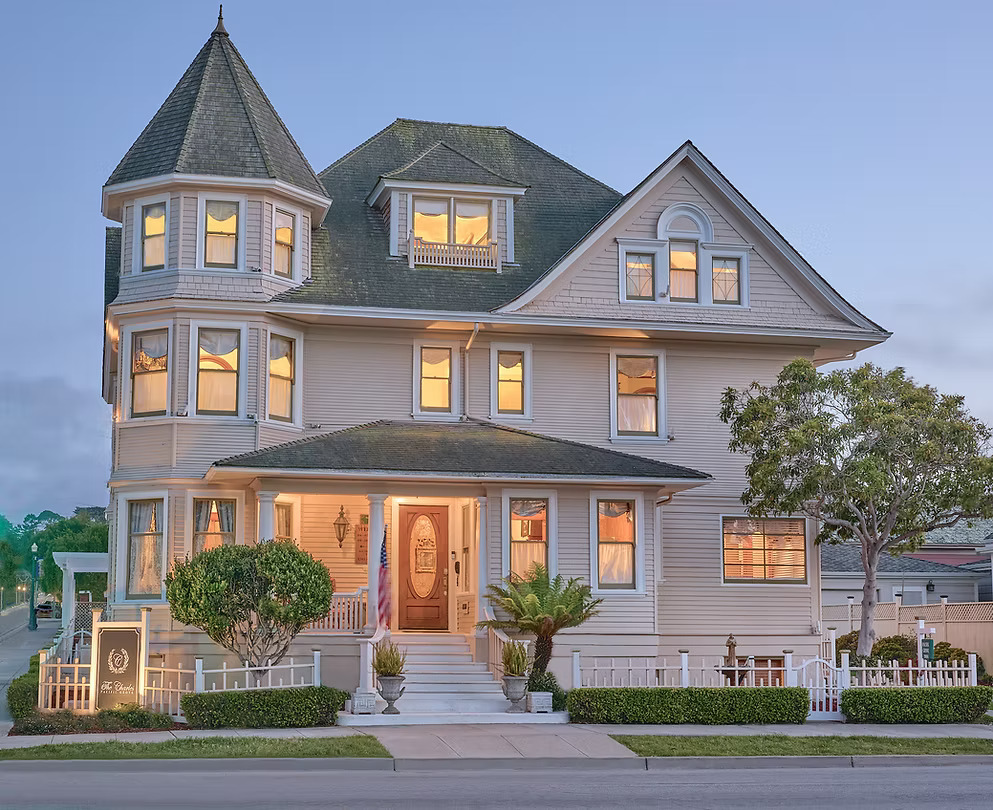
This last Pride month, The Charles, an exquisitely stylish bed and breakfast, opened its doors, making it Pacific Grove’s first LGBTQ+ boutique hotel. It isn’t just a place to stay; it is a place to belong, boasting an environment of inclusivity. This is a welcome sanctuary of coastal beauty and classic design that is both stylish and warm. Bringing over four decades of global influence and experience to the creation of the property is internationally celebrated designer Charles Gruwell, who, after 30 years away, returned home to Pacific Grove to establish this most personal location.
Gruwell has over 45 years of experience in design. He has designed acclaimed properties that span from the Monterey Peninsula, Los Angeles, Las Vegas, Indonesia, and the list goes on. He has earned a name as one of the top names in outstanding design and innovation.
His work ranges from designing over 40 one-of-a-kind boutique hotels and resorts to exclusive residential properties, restaurants, country clubs, and retail spaces – all boasting his signature flair and aesthetic. Gruwell has been featured in a long list of top industry publications that include Architectural Digest, Interior Design Magazine, and Metropolitan Home.
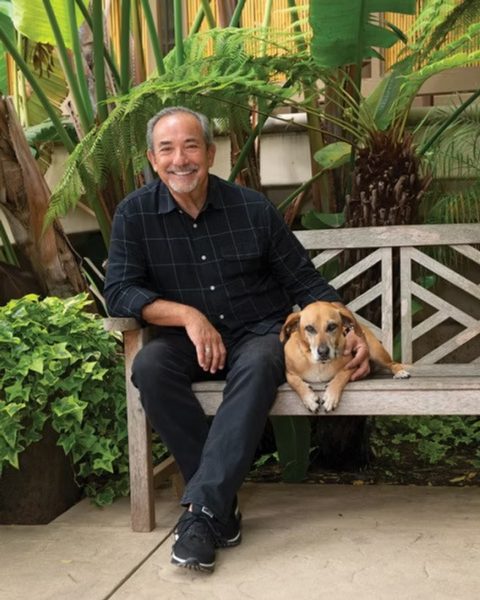
Gruwell was born and raised in Pacific Grove, which is located on the southern edge of Monterey Bay, and has become a popular tourist location because of its charm and location. His journey to become one of the industry’s leading names started off with a unique twist. After attending Fresno State College, he came back to Pacific Grove to work as a high school teacher for four years. It was during his teaching that we would meet his lifelong friend, interior designer Johna Ball. He would shadow her on her residential projects in Pebble Beach, and his passion for design came full force.
He went on to work for Hirsch Bedner, the largest hotel design firm in the world, at their location in Santa Monica. From then on, he spent his career away from Pacific Grove, starting his own business and traveling the globe, earning his place in the design world. His hometown was always close to his heart, and he fondly told the Blade about his first-ever professional gig – designing his niece’s hair salon in Pacific Grove.
Gruwell shared with the Blade what he thinks sets his work apart, “Every (designer) has their own talents and they all are in their own lane doing whatever they’re doing. But I have a really diverse background.” Gruwell’s first mentor was Marlene Grant, who had a very classical approach to interior design. He then worked for Michael Bedner, namesake of Hirsch Bedner, who trained him in hospitality design. His really big break came when he went to work with Anita Brooks, and together, they would design the Four Seasons and Mandalay Bay Resorts as well as the multi-million dollar residences of the casino owners. They also received a commission for Disney’s Animal Kingdom Lodge in Orlando, Florida. Gruwell continues, “All of those add up to life experiences that some designers never get. I have really diverse influences from different high-end design professionals in both the residential and hospitality marketplaces. I think what makes me a little more special.”
After years of travel and design, Gruwell’s mother fell ill and eventually passed away at 103. His friends encouraged him to come home, to leave the rat race and enjoy his time where he grew up. He returned to Pacific Grove and turned his mother’s lot into his new, customized home, close to the Ocean.
“I came back here because I wanted to be back to my roots. When I was growing up, I didn’t realize that I lived in the most beautiful place in the world. Now, at 73 years old, I know.”
Don’t think Gruwell is retiring or taking it easy. Since returning home, he has designed major hotels and a number of residences in Pebble Beach. But it was a call from a client that really spoke to him.
“Don (and Jay) Desai gave me the opportunity to design The Charles Pacific Grove. He said, ‘Let’s give you a namesake property, and let’s have you design it any way you want to. And let’s invite the LGBTQ community to a stylish and inclusive hotel.’ And so that brought me full circle.”
Though all of Gruwell’s properties have his signature style, The Charles is completely his, from start to finish. The building itself is part of his life; it is a Victorian-style home built by Frank Buck in 1904. Gruwell remembers being fascinated by the building as early as he can remember, passing by it constantly growing up. It turned into a boarding home, back to a residence, and then to a bed and breakfast. The building is listed on the National Register of Historic Places.
“The house itself is what spoke to me. The actual architecture of the Victorian House spoke to me and said, ‘Make me a beautiful, luxury, London-inspired residence.’ So, because of the architecture and all the woodworking on the inside, it just had this whole feeling of a grand home; the building is what guided me to do the design.”
Making The Charles truly his own also meant making it inclusive.
“In all my travels, I’ve gone to different hotels and no one ever really talks about them being inclusive, inviting the LGBTQ community to be seen and welcomed, and celebrated. They nod to it, but no one ever really makes a declaration about it. So, don’t we create a stylish, elegant interior and invite the LGBTQ+ community so they know they can come to Pacific Grove and stay in a stylish and inclusive hotel environment where they don’t have to make any explanations about who they are or what their preferences are. They can just come and feel welcome, they can be celebrated, and they can be the individuals that they are in our hotel.”
With queer travel on the decline because of changes and uncertainty in safety and being welcomed, The Charles is a stylish breath of fresh air that is at the center of an oceanside oasis where you can walk the from Lover’s Point into Monterey to Cannery Row. Cannery Row is home to the world-class Monterey Bay Aquarium. Restaurants, shopping, kayaking, surfing, paddle boarding, wine tasting, art galleries, and beachside rest are all must-dos when visiting. Carmel By the Sea, just five miles away, boasts one of the most beautiful white sand beaches around. Or you can just spend your time in any one of The Charles’ 16 luxury rooms.
And Gruwell’s message to the LGBTQ community this Pride season?
“Stand tall in your individuality, your diversity, and your equality, and know that you matter and you are relevant. Be true to yourself, and don’t let anyone bring you down.”
Visit The Charles Pacific Grove / 581 Pine St, Pacific Grove, CA, 93950
a&e features
Youth Poet Laureate Samantha Rios lends her voice to The Ford’s multimedia tribute to L.A
Get Lit – Words Ignite turns youth poetry into a citywide celebration

Los Angeles is loud and crowded – it is a city overflowing with sound and stories. Yet amid all the noise, it can be surprisingly hard to truly hear one voice. But Samantha “Sammy” Rios, poet and performer, cuts through the noise with unmistakable clarity. On August 1st, Rios will take the spotlight at The Ford as part of If I Awaken in Los Angeles, a one-night-only multimedia production that brings the city into sharp, luminous focus.
Presented by youth poetry powerhouse Get Lit – Words Ignite, in partnership with the LA Philharmonic and directed by Gina Belafonte, the show blends spoken word, music, dance, and immersive film to trace Los Angeles’s cultural geography. The show goes in-depth with the communities that define Los Angeles: from its Indigenous origins to Koreatown.
For Rios – a queer, Chicana poet and the current Los Angeles Youth Poet Laureate – the opportunity to be part of If I Awaken felt deeply personal. “I’ve been working with Get Lit for about three years now, and I’ve cherished every moment,” she says. “Being able to share the city, my family, and all the parts of L.A. that I hold so dear to my heart has been an unforgettable experience.”
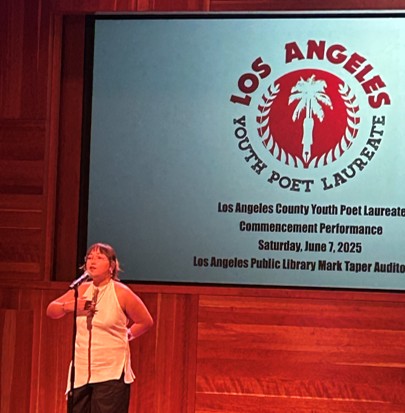
While the show’s vignettes stretch across the city – from Chinatown to South Central to the Canyons, Rios brings a different part of L.A. with her on stage. “I feel especially responsible for bringing the stories of East. L.A. and Boyle Heights to life,” she says.” This is particularly meaningful to her because her family was featured in the videos that will be presented when the show discusses East L.A. While working with Get Lit, one moment in particular made Rios emotional: bringing the crew to El Tepeyac, her favorite local restaurant. “It was something I never pictured happening – being able to share my family and show people just how special everyone in my little corner of life really is.”
The multimedia format of the show – film, live performance, music, and so on – challenges each poet to think in an interdisciplinary manner. For Rios, that means being mindful of the camera as much as the crowd. “When I’m on film, I try to think about how my performance looks on the other side of the camera,” she says, “but my writing remains rooted in my own voice.” Whether the world is overbearing or comfortable, Rios cannot stop writing.
In many ways, her work embodies what Get Lit teaches: that poetry is not just an artform, is civic engagement. It is a form of activism that teaches others about how to embrace the differences in other people. And for Rios, that connection between the political and personal is not theoretical – it is lived. “As a Chicana poet, a lot of what’s going on in politics is personal to me,” she says.
If I Awaken In Los Angeles reimagines the city as a vibrant, creative canvas, where Rios is the artist. “This show allowed me to go into different communities and meet people personally.” She leaves the Blade with an endearing note: “We’re all united in our own special way.” And in a city too often reduced to freeways and noise that cannot be quieted, that kind of unity is revolutionary.
—
Event Details:
If I Awaken In Los Angeles Presented by Get Lit – Words Ignite in partnership with the LA Phil
Venue: The Ford | 2580 Cahuenga Blvd E, Los Angeles, CA 90068
Date: August 1, 2025
Time: Doors open at 6:30 pm/ Show starts at 8pm
Location: The Ford, 2580 Cahuenga Blvd E, Los Angeles, CA 90068
Tickets:https://www.theford.com/events/performances/4068/2025-08-01/if-i-awaken-in-los-angeles
Events
Los Angeles Blade to take special part in NLGJA Los Angeles inaugural journalism awards
Three inaugural journalism awards will honor those who championed LGBTQ+ stories in 2024, including the Troy Masters Legacy Award for Visionaries in Media, in honor and memory of our founding publisher.
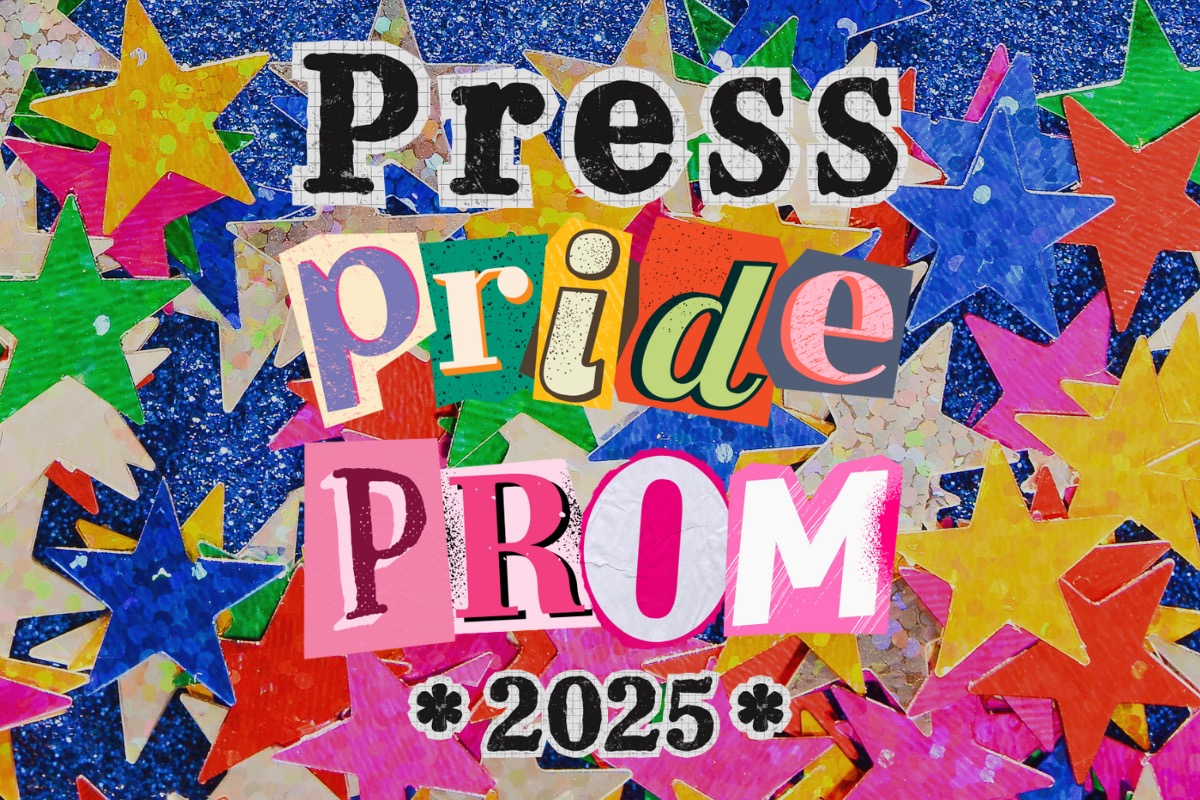
On July 26, 2025, at the Grand Central Air Terminal, the Los Angeles chapter of the NLGJA, the Association of LGBTQ+ Journalists, will host Press Pride Prom, a benefit and awards ceremony honoring Southern California journalists and newsrooms. Three inaugural journalism awards will honor those who championed LGBTQ+ stories in 2024.
The Los Angeles Blade, in collaboration with the NLGJA, will present the Troy Masters Legacy Award for Visionaries in Media, honoring a journalist or news media professional whose work reflects a dedication to the craft of journalism and a commitment to setting the stage for the next generation of LGBTQ+ industry leaders. Troy Masters was a veteran, queer journalist, and founding publisher of the Los Angeles Blade who passed away unexpectedly last year.
The inaugural nominees are nominees include Mariah Castañeda, co-founder of LA Public Press; veteran journalist LZ Granderson, who currently serves as an OpEd columnist for the Los Angeles Times and an ABC News contributor; and John Griffiths, founder of GALECA: The Society of LGBTQ Entertainment Critics and Dorian Awards.
The Los Angeles Blade is honored to be given this opportunity by the NLGJA to pay homage in such a profound way to Masters and the legacy he created, and that the Blade continues to cultivate, for the queer community.
NLGJA LA co-president Hansen Bursic shared, “We are honored to present an award this year in honor of beloved Los Angeles publisher and journalist Troy Masters. These nominees embody Masters’ dedication to LGBTQ+ journalism and his passion for community building in Southern California and beyond.”
The Los Angeles Blade is further honored to be listed as a nominee for the event’s Excellence in LGBTQ+ Reporting Newsroom Award, honoring a news outlet whose coverage of the queer and trans community is well-informed, complex, varied and intersectional, with a track record of promoting The Association of LGBTQ+ Journalists’ mission to advance fair and accurate coverage of LGBTQ+ communities and issues. We are nominated alongside LAist and Variety.
The evening will also include the presentation of the Queer Beat Award for Excellence in LGBTQ+ Reporting, honoring a single story or series that demonstrates care, skill, and a commitment to fair and accurate reporting of LGBTQ+ themes, issues, and people. The nominees include A Night They Can’t Remember, at One of the Country’s Most Popular LGBTQ+ Bars by Kate Sosin and Steven Blum for The 19th; Banned Rainbows and ‘Forced Outing.’ Will Elections Reshape This Relentless School Board? by Jaweed Kaleem for the Los Angeles Times; and She Was Supposed to Be at Pulse Nightclub — And Club Q. Now She’s Fighting To Keep LGBTQ+ People Safe by Lil Kalish for HuffPost.
NLGJA LA co-president Katie Karl remarked, “These nominees represent the diverse and passionate spirit of Southern California’s LGBTQ+ journalism community. At a time when queer and trans stories and journalists are under attack, we are proud to uplift a few of the incredibly talented journalists who are speaking truth to power and helping tell our community’s stories.”
The awards, presented by ABC7, will be hosted by veteran LA-based journalist and GLAAD award winner, Tracy Gilchrist. The ceremony will be held on July 26 from 6 to 9 p.m. in Glendale at the historic Grand Central Air Terminal. The evening will be prom-themed, giving attendees the opportunity to relive high school memories as their authentic selves.
Early bird tickets are on sale now until June 20. Tables and regular tickets will also be available
to purchase through July 18. You can learn more and get tickets here.
Arts & Entertainment
2025 Emmy nominations: ‘Hacks’ and ‘The Last of Us’ bring queer excellence to the table
‘Hacks’ and ‘The Last of Us’ are two of the most notable LGBTQ+ shows nominated at this year’s Primetime Emmys.
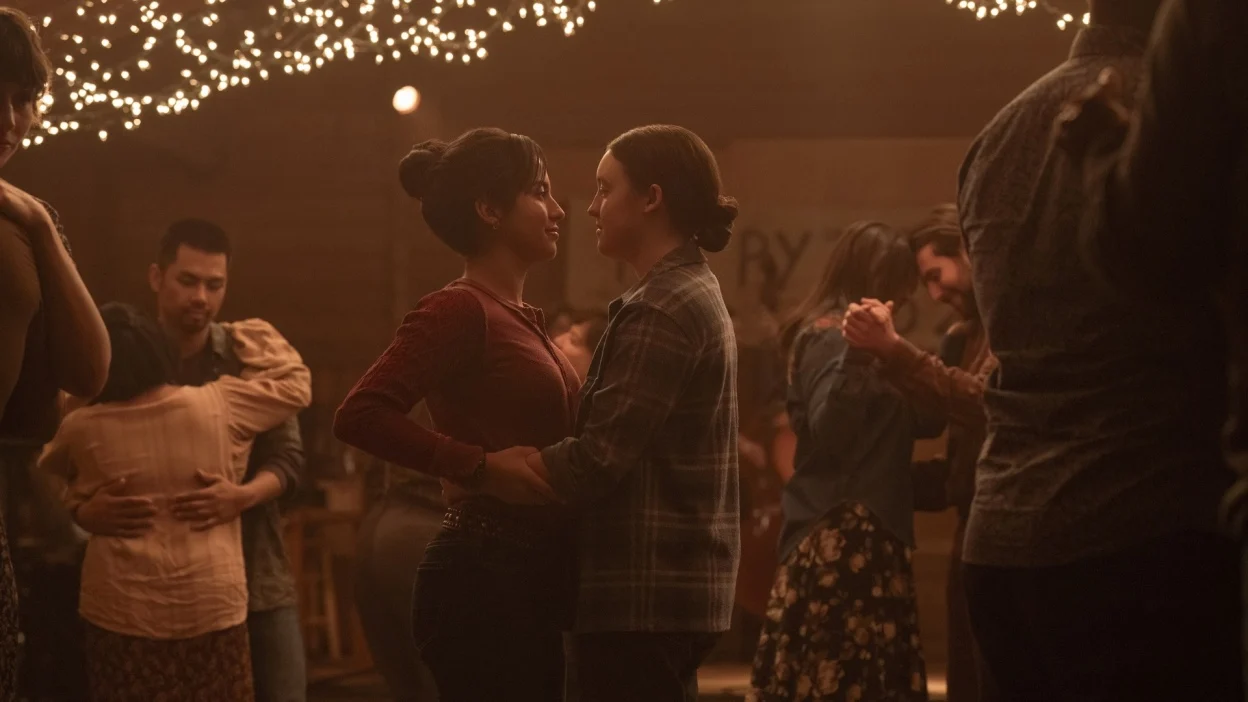
Earlier today, the 2025 Primetime Emmy nominations were announced, and a few of this year’s key frontrunners have particularly resonated with the LGBTQ+ community during a politically turbulent year.
Coming off Season 3’s win for outstanding comedy series, Hacks Season 4 was nominated for 14 awards, with Jean Smart, Hannah Einbinder, Julianne Nicholson, and Robby Hoffman being recognized for their performances. Since the show premiered in 2021, each season has explored the comedy and entertainment industry through the lens of generational differences between queer writer Ava (Einbinder) and the old-school Deborah (Smart).
While Smart has won outstanding lead actress in a comedy series for all three seasons, this year could be the chance for Einbinder, who identifies as bisexual, to finally take home a prize of her own in supporting actress. And if Season 4 nabs the outstanding comedy series crown yet again, it’ll be another huge moment for bisexual representation. But it will have to fend off the industry satire The Studio, which received a staggering 23 nominations for its breakout first season.
Another one of this year’s most high-profile contenders, The Last of Us, received 16 nominations for its second season, including non-binary actor Bella Ramsey, lead actor Pedro Pascal, and supporting/guest actors Kaitlyn Dever, Jeffrey Wright, Joe Pantoliano, and Catherine O’Hara.
Notably, though, Season 2 has been hit by much more backlash, much of which has been fueled by homophobic anger at the love story between Ellie (Ramsey) and Dina (Isabela Merced). Merced, who identifies as queer, was widely praised for her turn as Dina, but was not nominated for supporting actress. And while Season 1 received 24 nominations, Season 2 lost out on a few, bringing The Last of Us down a notch in its overall standing.
There were other snubs as well. Mid-Century Modern, the gay sitcom starring Nathan Lane, Matt Bomer, Nathan Lee Graham, and Linda Lavin, did not see any of its actors nominated. It also missed out on the Best Comedy Series category, for which it was considered a contender, although it did still receive four below-the-line nominations.
However, other openly queer actors were nominated, even for roles or shows not explicitly exploring queer issues or characters. Those include Colman Domingo for The Four Seasons, Cynthia Erivo for Poker Face, Michael Urie for Shrinking, Cooper Koch for Monsters: The Lyle & Erik Menendez Story, and Bowen Yang for Saturday Night Live.
Of course, it wouldn’t be the Emmys without RuPaul, who became the most-nominated reality host in Emmys history after landing his 10th nomination for RuPaul’s Drag Race. He’s also nominated alongside Alan Cumming of The Traitors fame. And in the Outstanding Documentary or Nonfiction special category, the critically acclaimed Will & Harper and Pee-wee as Himself were nominated, and are both considered strong contenders to win.
TV fans can find out which of their favorite queer actors or shows take home top prizes on Sunday, Sept. 14, with Nate Bargatze hosting the 77th annual awards at the Peacock Theater in Los Angeles.
-
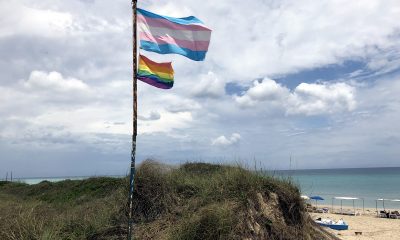
 Cuba4 days ago
Cuba4 days agoCuban lawmakers simplify process for trans people to change IDs
-
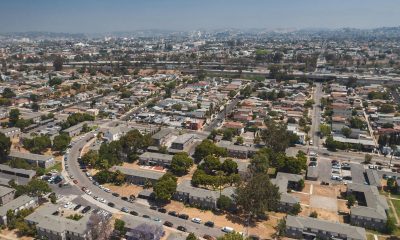
 Commentary2 days ago
Commentary2 days agoThe Westside is unaffordable. Allowing for more housing can help
-
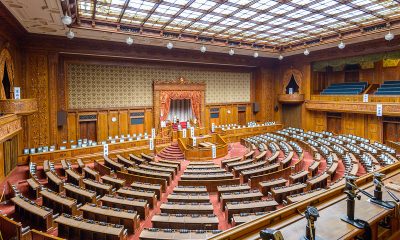
 Japan4 days ago
Japan4 days agoAnti-LGBTQ+ party gains power in Japanese Diet
-

 California2 days ago
California2 days agoKamala Harris opts out of Governor’s race: What does that mean for 2028 and trans rights?
-

 News4 days ago
News4 days agoWest Hollywood joins coalition against ICE raids, standing up for queer immigrants
-

 Features12 hours ago
Features12 hours agoStill here, still fighting: A trans Latina’s stand against ICE in Orange County
-
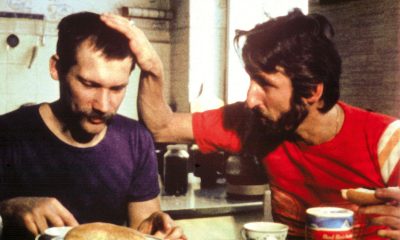
 Movies2 days ago
Movies2 days agoRestored film offers inside look at ‘80s gay Berlin
-
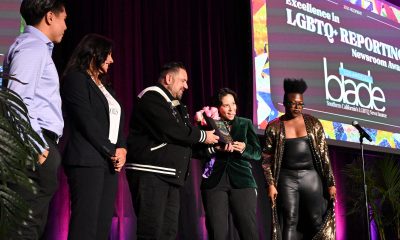
 Events2 days ago
Events2 days agoThe Blade wins Excellence in LGBTQ+ Reporting Newsroom Award at NLGJA Los Angeles Press Pride event
-
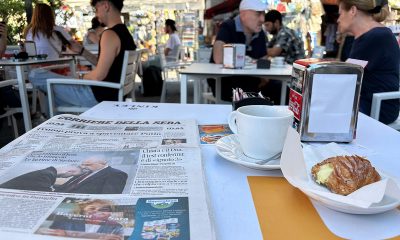
 Opinions2 days ago
Opinions2 days agoVacationing abroad with an embarrassment in the White House
-
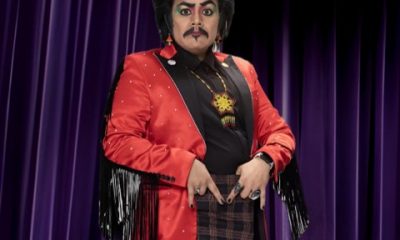
 a&e features2 days ago
a&e features2 days agoCharles Galin King brings cultural influences and style to Revry’s ‘King of Drag,’ the first-ever drag king television competition series
